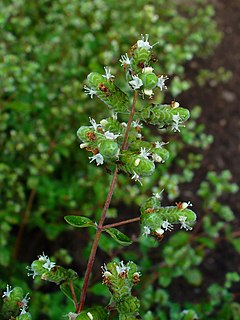
Marjoram is a cold-sensitive perennial herb or undershrub with sweet pine and citrus flavours. In some Middle Eastern countries, marjoram is synonymous with oregano, and there the names sweet marjoram and knotted marjoram are used to distinguish it from other plants of the genus Origanum. It is also called pot marjoram, although this name is also used for other cultivated species of Origanum.

Hibiscus rosa-sinensis, known colloquially as Chinese hibiscus, China rose, Hawaiian hibiscus, rose mallow and shoeblackplant, is a species of tropical hibiscus, a flowering plant in the Hibisceae tribe of the family Malvaceae. It is widely cultivated in tropical and subtropical regions, but is not known in the wild, so that its native distribution is uncertain. An origin in some part of tropical Asia is likely. It is widely grown as an ornamental plant in the tropics and subtropics.

Manilkara zapota, commonly known as sapodilla, sapota, chikoo, chico, naseberry, or nispero is a long-lived, evergreen tree native to southern Mexico, Central America and the Caribbean. An example natural occurrence is in coastal Yucatán in the Petenes mangroves ecoregion, where it is a subdominant plant species. It was introduced to the Philippines during Spanish colonization. It is grown in large quantities in India, Pakistan, Thailand, Malaysia, Cambodia, Indonesia, Vietnam, Bangladesh and Mexico.
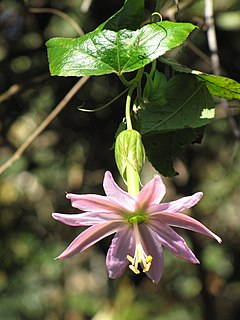
Passiflora tarminiana is a species of passionfruit. The yellow fruits are edible and their resemblance to small, straight bananas has given it the name banana passionfruit in some countries. It is native to the uplands of tropical South America and is now cultivated in many countries. In Hawaii and New Zealand it is now considered an invasive species. It was given the name banana passionfruit in New Zealand, where passionfruit are also prevalent. In Hawaii, it is called banana poka. In its Latin American homeland, it is known as curuba, curuba de Castilla, or curuba sabanera blanca (Colombia); taxo, tacso, tagso, tauso (Ecuador); parcha, taxo (Venezuela), tumbo or curuba (Bolivia); tacso, tumbo, tumbo del norte, trompos, tintin or purpur (Peru).

Premnas biaculeatus, commonly known as spine-cheeked anemonefish or the maroon clownfish, is a species of anemonefish found in the Indo-Pacific from western Indonesia to Taiwan and the Great Barrier Reef. They can grow up to be about 17 cm (6.7 in). Like all anemonefishes it forms a symbiotic mutualism with sea anemones and is unaffected by the stinging tentacles of the host anemone. It is a sequential hermaphrodite with a strict size-based dominance hierarchy; the female is largest, the breeding male is second largest, and the male nonbreeders get progressively smaller as the hierarchy descends. They exhibit protandry, meaning the breeding male changes to female if the sole breeding female dies, with the largest nonbreeder becoming the breeding male. The fish's natural diet includes algae and zooplankton.

Santalum album, or Indian sandalwood, is a small tropical tree, and the traditional source of sandalwood oil. It is native to southern India and Southeast Asia. It is considered sacred in some religions like Hinduism, and some cultures place great significance on its fragrant and medicinal qualities. However, the high value of the species has caused over-exploitation, to the point where the wild population is vulnerable to extinction. Indian sandalwood still commands high prices for its essential oil owing to its high alpha santalol content, but due to lack of sizable trees it is no longer used for fine woodworking as before. The plant is long-lived, but harvest is only viable after many years.

Carissa spinarum, the conkerberry or bush plum, is a large shrub of the dogbane family (Apocynaceae), widely distributed in tropical regions of Africa, Southern Asia, Australia, and various islands of the Indian Ocean. It is most well known in Australia, where it is also called currant bush or, more ambiguously, native currant or even black currant. It is, however, neither closely related to plums (Prunus) nor to true currants (Ribes), which belong to entirely different lineages of eudicots. In India, it is also called wild karanda /wild karavanda, referring to the related karanda. Carissa spinarum is often discussed under its many obsolete synonyms.

Alstonia scholaris, commonly called blackboard tree or devil's tree in English, is an evergreen tropical tree in the family Apocynaceae. It is native to southern China, tropical Asia and Australasia, it is a commonly planted ornamental plant in these areas. It is a toxic plant, but traditionally it is used medicinally for myriad diseases and complaints.
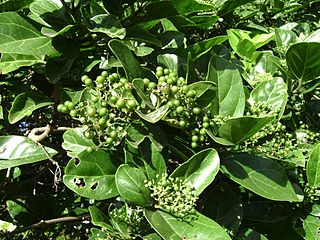
Premna is a genus of flowering plants in the mint family, Lamiaceae, first described for modern science in 1771. It is widespread through tropical and subtropical regions in Africa, southern Asia, northern Australia, and various islands in the Pacific and Indian Oceans.
- Premna acuminataR.Br. - Australia, New Guinea
- Premna acutataW.W.Sm. - southwestern China
- Premna albaH.J.Lam - Palau
- Premna ambongensisMoldenke - Madagascar
- Premna amplectensWall. ex Schauer - Thailand, Myanmar
- Premna angolensisGürke - tropical Africa
- Premna angustifloraH.J.Lam - Palau
- Premna annulataH.R.Fletcher - Thailand, Laos, Vietnam
- Premna aureolepidotaMoldenke - Madagascar
- Premna balakrishnaniiA.Rajendran & P.Daniel - Tamil Nadu
- Premna balansaeDop - Vietnam
- Premna barbataWall. ex Schauer - Indian Subcontinent, Myanmar
- Premna bengalensisC.B.Clarke - Indian Subcontinent, Myanmar, Vietnam
- Premna bequaertiiMoldenke - Uganda, Rwanda, Zaïre
- Premna bracteataWall. ex C.B.Clarke - Himalayas, Tibet, Yunnan, Nepal, Assam, Bhutan, Myanmar
- Premna cambodianaDop - Cambodia, Vietnam
- Premna cavalerieiH.Lév - China
- Premna chevalieriDop - Thailand, Laos, Vietnam, China
- Premna chrysoclada(Bojer) Gürke - Kenya, Tanzania, Guinea-Bissau
- Premna collinsaeCraib - Thailand
- Premna confinisC.Pei & S.L.Chen ex C.Y.Wu - China
- Premna congolensisMoldenke - Zaïre, Angola, Cabinda
- Premna cordifoliaRoxb. - Thailand, Vietnam, Malaya
- Premna coriaceaC.B.Clarke - Indian Subcontinent, Thailand, Andaman Islands
- Premna corymbosaRottler - India, Sri Lanka, Andaman & Nicobar Islands
- Premna crassaHand.-Mazz. - Vietnam, China
- Premna debianaA.Rajendran & P.Daniel - Arunachal Pradesh
- Premna decaryiMoldenke - Madagascar
- Premna decurrensH.J.Lam - Indonesia
- Premna discolorVerdc. - Kenya
- Premna dubiaCraib - Laos, Thailand, Vietnam
- Premna esculentaRoxb. - Assam, Bangladesh, Myanmar, Thailand
- Premna fohaiensisC.Pei & S.L.Chen ex C.Y.Wu - China (Yunnan)
- Premna fordiiDunn - China
- Premna fulvaCraib - Indochina, Indonesia, China
- Premna garrettiiH.R.Fletcher - Thailand
- Premna glaberrimaWight - southern India
- Premna glandulosaHand.-Mazz. - China (Yunnan)
- Premna gracillimaVerdc. - Kenya, Tanzania
- Premna grandifoliaA.D.J. Meeuse, illegitimate name, = Premna hutchinsonii
- Premna grossaWall. ex Schauer - Myanmar
- Premna guillauminiiMoldenke - New Caledonia
- Premna hainanensisChun & F.C.How - China (Hainan)
- Premna hans-joachimiiVerdc. - Tanzania
- Premna henryana(Hand.-Mazz.) C.Y.Wu - China
- Premna herbaceaRoxb. - Himalayas, Yunnan, Indian Subcontinent, Southeast Asia, Indonesia, New Guinea, northern Australia
- Premna hildebrandtiiGürke - Zaire, Kenya, Tanzania, Mozambique, Zimbabwe
- Premna hispidaBenth. - West Africa
- Premna humbertiiMoldenke - Madagascar
- Premna hutchinsoniiMoldenke - Ivory Coast
- Premna interruptaWall. ex Schauer - southern China, Himalayas, Indochina
- Premna jalpaigurianaT.K.Paul - West Bengal
- Premna khasianaC.B.Clarke - Assam, Thailand
- Premna lepidellaMoldenke - Madagascar
- Premna ligustroidesHemsl - China
- Premna longiacuminataMoldenke - Madagascar
- Premna longifoliaRoxb. - Himalayas
- Premna longipetiolataMoldenke - Madagascar
- Premna lucensA.Chev. - West Africa
- Premna macrophyllaWall. ex Schauer - Assam, Indochina
- Premna madagascariensisMoldenke - Madagascar
- Premna mariannarumSchauer - Mariana Islands
- Premna matadiensisMoldenke - Zaïre, Angola
- Premna maximaT.C.E. Fr. - Kenya
- Premna mekongensisW.W.Sm. - China (Yunnan)
- Premna micranthaSchauer - India, Assam, Bangladesh
- Premna microphyllaTurcz. - Japan, Ryukyu Islands, China
- Premna millefloraC.B.Clarke - Assam
- Premna milneiBaker - Nigeria, Bioko
- Premna minorDomin - Queensland
- Premna mollissimaRoth - Indian Subcontinent, Yunnan, Indochina, Philippines
- Premna mooiensis(H.Pearson) W.Piep - Mozambique, Swaziland, South Africa
- Premna mortehaniiDe Wild - Zaïre
- Premna mundanthuraiensisA.Rajendran & P.Daniel - Tamil Nadu
- Premna neurophyllaChiov. - Ethiopia
- Premna oblongataMiq. - Indonesia, Philippines
- Premna odorataBlanco - - Indian Subcontinent, Yunnan, Southeast Asia, New Guinea, northern Australia; naturalized in Miami-Dade County in Florida
- Premna oliganthaC.Y.Wu - China
- Premna oligotrichaBaker - Ethiopia, Somalia, Kenya, Tanzania
- Premna orangeanaCapuron - Madagascar
- Premna paisehensisC.Pei & S.L.Chen - China (Guangxi)
- Premna pallescensRidl.- Borneo, Indonesia
- Premna parasiticaBlume - Indonesia
- Premna parvilimbaC.Pei - China (Yunnan)
- Premna paucinervis(C.B.Clarke) Gamble - Kerala, Tamil Nadu
- Premna paulobarbataH.J.Lam - Mariana Islands
- Premna perplexansMoldenke - Madagascar
- Premna perrieriMoldenke - Madagascar
- Premna pinguisC.B.Clarke - Assam, Bangladesh, Myanmar, Java
- Premna politaHiern - Angola
- Premna procumbensMoon - India, Bangladesh, Sri Lanka
- Premna protrusaA.C.Sm. & S.Darwin - Fiji
- Premna puberulaPamp. - China
- Premna pubescensBlume - Indonesia, Philippines, Christmas Island
- Premna puerensisY.Y.Qian - China (Yunnan)
- Premna punduanaWall. ex Schauer - Arunachal Pradesh, Assam, Bangladesh
- Premna puniceaC.Y.Wu - China (Yunnan)
- Premna purpurascensThwaites - Sri Lanka
- Premna quadrifoliaSchumach. & Thonn. - West Africa
- Premna rabakensisMoldenke - Cambodia
- Premna regularisH.J.Lam - Philippines, Indonesia, New Guinea
- Premna repensH.R.Fletcher - Thailand
- Premna resinosa(Hochst.) Schauer - East Africa, Arabian Peninsula, India
- Premna richardsiaeMoldenke - Tanzania
- Premna rubroglandulosaC.Y.Wu - China (Yunnan)
- Premna scandensRoxb. - China (Yunnan), Himalayas, Andaman Island, Indochina
- Premna schimperiEngl - East Africa
- Premna schliebeniiWerderm. - Tanzania, Mozambique
- Premna scoriarumW.W.Sm. - Tibet, Yunnan, Myanmar
- Premna senensisKlotzsch - eastern + central Africa
- Premna serrataH.R.Fletcher - Thailand
- Premna serratifoliaL. - widespread in East Africa, the Indian Subcontinent, Southeast Asia, northern Australia, islands of Pacific + Indian Oceans
- Premna siamensisH.R.Fletcher - Thailand
- Premna stenobotrysMerr. - Vietnam
- Premna steppicolaHand.-Mazz. - China
- †Premna sterculiifoliaKing & Gamble - Malaya but extinct
- Premna straminicaulisC.Y.Wu - China (Yunnan)
- Premna subcapitataRehder - China
- Premna sulphurea(Baker) Gürke - Angola
- Premna sunyiensisC.Pei - China (Guangdong)
- Premna szemaoensisPei - China (Yunnan)
- Premna tahitensisJ.Schauer - many islands of the Pacific
- Premna tanganyikensisMoldenke - Tanzania, Mozambique
- Premna tapintzeanaDop - China (Yunnan)
- Premna teniiC.Pei - China (Yunnan)
- Premna thoreliiDop - Laos
- Premna thwaitesiiC.B.Clarke - Sri Lanka
- Premna tomentosaWilld. - Indian Subcontinent, Southeast Asia, Queensland, Solomon Islands
- Premna trichostomaMiq. - Southeast Asia, Indonesia, New Guinea
- Premna urticifoliaRehder - China (Yunnan)
- Premna velutinaGürke - Burundi, Kenya, Tanzania, Mozambique
- Premna venulosaMoldenke - Madagascar
- Premna wightianaSchauer - India, Sri Lanka
- Premna wuiBoufford & B.M.Barthol. - China (Yunnan)
- Premna yunnanensisW.W.Sm - China

Ipomoea nil is a species of Ipomoea morning glory known by several common names, including picotee morning glory, ivy morning glory, and Japanese morning glory. It is native to the tropical Americas, and has been introduced widely across the world.
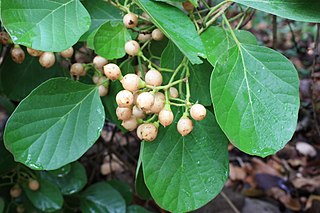
Cordia myxa is a species of flowering plant in the borage family, Boraginaceae. It is a medium-sized broad-leaved deciduous tree. Common names include Assyrian plum, lasura, laveda, pidar, panugeri, naruvilli, geduri, spistan, burgund dulu wanan and ntege. It is found growing primarily in Asia, as well as, across the globe especially in tropical regions having the right type of geophysical environment. It is seen coming up naturally and growing abundantly from Myanmar in the east to Lebanon and Syria in the west. Its habitat starts at about 200 m above mean sea level in the plains and ascends to an altitude around 1,500 m in the hills.
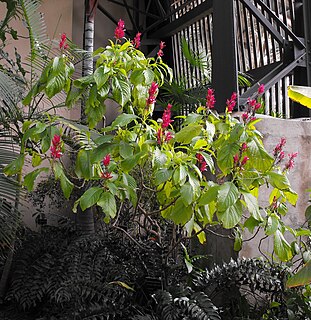
Megaskepasma is a monotypic genus of plants containing the single species Megaskepasma erythrochlamys, known by the common name Brazilian red-cloak. Native to Venezuela and elsewhere in South America, it is a free branching, upright showy tropical shrub that grows to 3 m high with appressed reddish hairs, stout stems, and broad ovate 12–30 cm long dark green leaves with pink midrib. It is grown as an ornamental shrub in climates from warm temperate to tropical for its inflorescence, large erect heads of conspicuous crimson bracts, and two-lipped white flowers. This plant prefers a rich soil and is propagated from seed or cuttings.

Premna serratifolia is a small tree/shrub in the family Lamiaceae. It flowers and fruits between May and November. During flowering season, it attracts a large number of butterflies and bees. Synonyms of Premna serratifolia Linn. include P. corymbosa Merr., P. integrifolia L. and P. obtusifolia R. Br.).

Centrosema virginianum is known by the common names of Spurred Butterfly Pea, wild blue vine, blue bell, and wild pea. C. virginianum is a member of the family Fabaceae, it is identified by its trailing and twining vine and showy flowers. C. virginianum habitats are in sunny areas within pine lands, and coastal uplands.
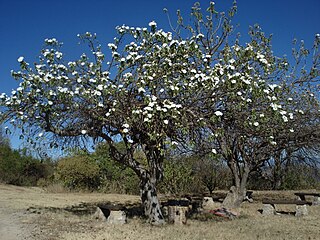
Ipomoea arborescens, the tree morning glory, is a rapidly-growing, semi-succulent flowering tree in the family Convolvulaceae. This tropical plant is mostly found in Mexico, and flowers in late autumn and winter. Its common name in Nahuatl is Cazahuatl or Cazahuate.
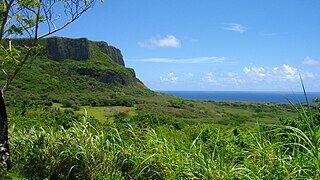
The Marianas tropical dry forests is a tropical and subtropical dry broadleaf forests ecoregion on the Marianas Islands in the western Pacific Ocean.
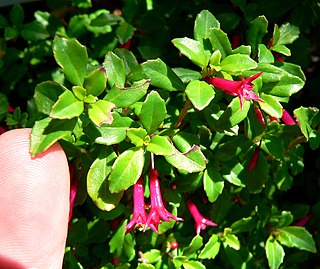
Fuchsia microphylla, also known as small leaf fuchsia and small-leaved fuchsia, is a flowering shrub in the family Onagraceae. The specific epithet (microphylla) was named for the plant's small (micro) leaves (phylla).
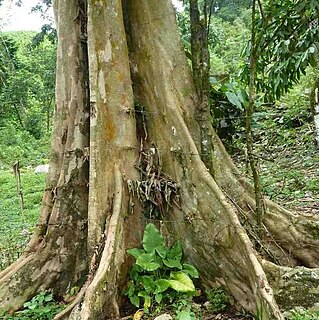
Licania platypus, also known as sun sapote, sansapote, sonzapote, sunzapote, sungano, zapote cabelludo, sapote, sangre, zapote amarillo, zapote borracho, zapote cabello, zapote de mico, zapote de mono, mesonsapote, mezonzapote, cabeza de mico, caca de nino, sonza, sunza, zunza, chaute jolobob, urraco, chupa, and monkey apple, is a flowering tree in the family Chrysobalanaceae.
Couepia polyandra, also known as olosapo, zapote amarillo, baboon cap, and monkey cap, is a flowering tree in the family Chrysobalanaceae.

Litsea garciae, also known as engkala, kalangkala, kangkala, medang, pangalaban, ta'ang, malai, wuru lilin, kelimah, bua talal, kelime, kelimie, bua' vengolobon, wi lahal, kelima, mali, beva' mali, kayu mali, malei, pengalaban, pengolaban, kupa, pipi, bagnolo, lan yu mu jiang zi, lan yu mu, buah tebuluh, tebulus, pong labon, and Borneo avocado, is a flowering tree in the family Lauraceae.

















